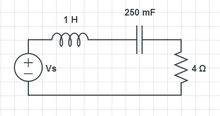Circuit Theory/Convolution Integral/Examples/example49
< Circuit Theory < Convolution Integral < Examples
Given that the source voltage is (2t-3t2), find voltage across the resistor.
Can do focused on Vr or: current, Vc, or VL before converting to Vr .. Below is the VR solution.
Outline:
Transfer Function
simplify(4/(4 + s + 1/(0.25*s)))
Homogeneous Solution
solve(s^2 + 4.0*s + 4.0,s)
There are two equal roots at s = -2, so the solution has the form:
Particular Solution
After a long time attached to a unit step function source, the inductor has shorted and the capacitor has opened. All the drop is across the capacitor. The current is zero.
This also means that C1 has to be zero.
Initial Conditions
So far the full equation is:
Initial current through the series leg is zero because of the assumed initial conditions of the inductor. This means VR = 0:
Assuming the initial voltage across the capacitor is zero, no current is flowing so the drop across the resistor is zero.
Impulse Solution
Taking the derivative of the above get:
Convolution Integral
f := (4*exp(-2*(t-x)) - 8*(t-x)exp(-2*(t-x)))*(2*x-3*x^2); S :=int(f,x=0..t)
There will not be any constant since again, V_R(t) = 0 after a long time ... and the capacitor opens.